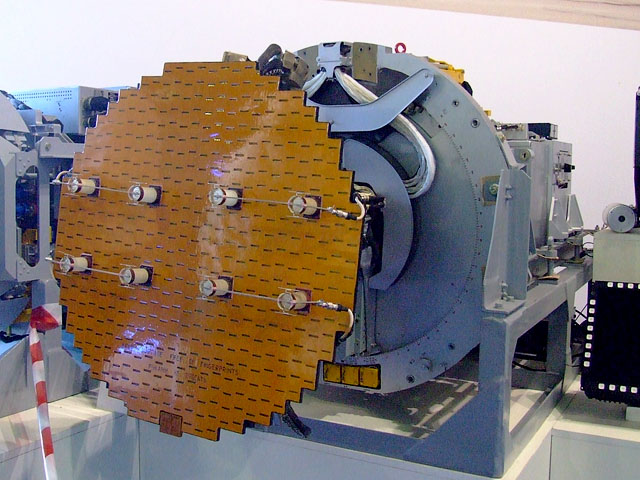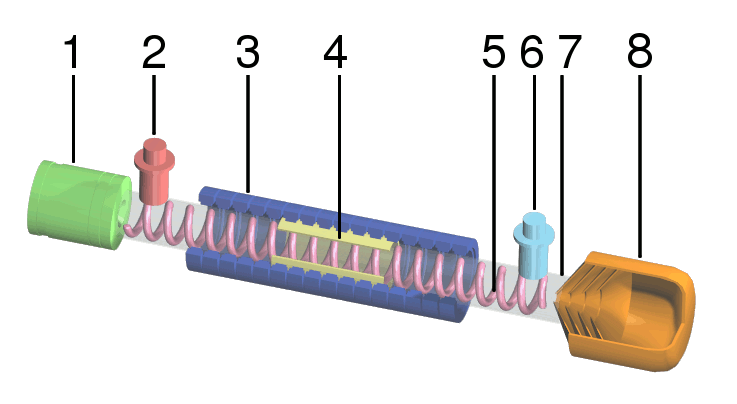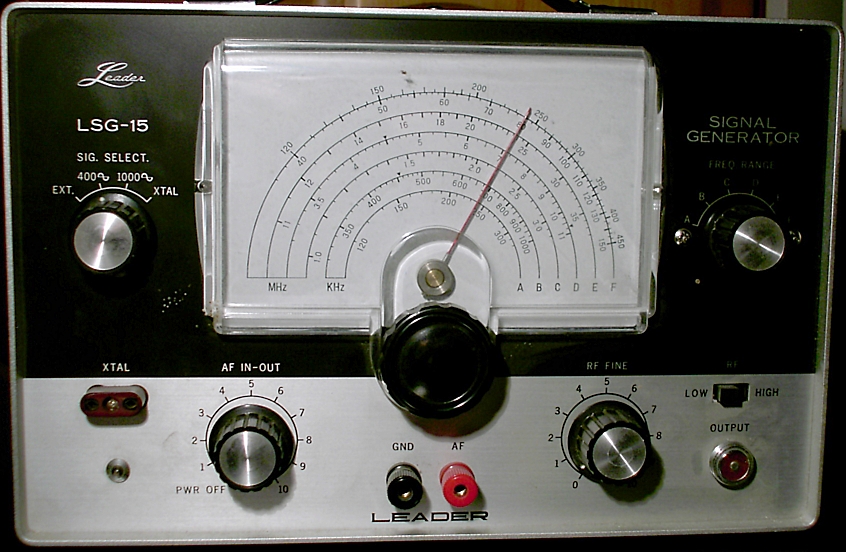|
AN APG-68
The AN/APG-68 radar is a long range (up to 296 km) Pulse-doppler radar designed by Westinghouse (now Northrop Grumman) to replace AN/APG-66 radar in the F-16 Fighting Falcon. The AN/APG-68(V)8 and earlier radar system consists of the following line-replaceable units: * Antenna * Dual Mode Transmitter (DMT) * Modular Low-power radio frequency (MLPRF) * Programmable signal processor (PSP) The AN/APG-68(V)9 radar system consists of the following line-replaceable units: * Antenna * Medium Duty Transmitter (MDT) * Modular Receiver/Exciter (MoRE) * Common Radar Processor (CoRP) The AN/APG-68(V)9 radar is the latest development. Besides the increase in scan range compared to the previous version, it has a Synthetic aperture radar (SAR) capability. The APG-68(V)9 has equipped several variants, including the Egyptian Air Force, Israeli Air Force, Chilean Air Force, Republic of Singapore Air Force, Turkish Air Force, Royal Moroccan Air Force, Greek Air Force, Pakistan Air Force ... [...More Info...] [...Related Items...] OR: [Wikipedia] [Google] [Baidu] |
Pulse-doppler
A pulse-Doppler radar is a radar system that determines the range to a target using pulse-timing techniques, and uses the Doppler effect of the returned signal to determine the target object's velocity. It combines the features of pulse radars and continuous-wave radars, which were formerly separate due to the complexity of the electronics. The first operational Pulse Doppler radar was in the CIM-10 Bomarc, an American long range supersonic missile powered by ramjet engines, and which was armed with a W40 nuclear weapon to destroy entire formations of attacking enemy aircraft. Pulse-Doppler systems were first widely used on fighter aircraft starting in the 1960s. Earlier radars had used pulse-timing in order to determine range and the angle of the antenna (or similar means) to determine the bearing. However, this only worked when the radar antenna was not pointed down; in that case the reflection off the ground overwhelmed any returns from other objects. As the ground moves at the ... [...More Info...] [...Related Items...] OR: [Wikipedia] [Google] [Baidu] |
Royal Thai Air Force
"Royal Thai Air Force March" , mascot = , anniversaries = 9 April 1937 (Royal Thai Air Force Day) , equipment = , equipment_label = , battles = , decorations = , battle_honours = , battle_honours_label = , flying_hours = , website = , commander1 = Air Chief Marshal Alongkorn Wannarot , commander1_label = List of Commanders of the Royal Thai Air Force, Commander-in-Chief , notable_commanders = , identification_symbol = , identification_symbol_label = Military aircraft insignia, Roundel , identification_symbol_2 = , identification_symbol_2_label = Fin flash , identification_symbol_3 = , identification_symbol_3_label = Flag , aircraft_attack = Dassault-Breguet/Dornier Alpha Jet, Alpha Jet A, Genera ... [...More Info...] [...Related Items...] OR: [Wikipedia] [Google] [Baidu] |
Military Radars Of The United States
A military, also known collectively as armed forces, is a heavily armed, highly organized force primarily intended for warfare. It is typically authorized and maintained by a sovereign state, with its members identifiable by their distinct military uniform. It may consist of one or more military branches such as an army, navy, air force, space force, marines, or coast guard. The main task of the military is usually defined as defence of the state and its interests against external armed threats. In broad usage, the terms ''armed forces'' and ''military'' are often treated as synonymous, although in technical usage a distinction is sometimes made in which a country's armed forces may include both its military and other paramilitary forces. There are various forms of irregular military forces, not belonging to a recognized state; though they share many attributes with regular military forces, they are less often referred to as simply ''military''. A nation's military may f ... [...More Info...] [...Related Items...] OR: [Wikipedia] [Google] [Baidu] |
Aircraft Radars
An aircraft is a vehicle that is able to fly by gaining support from the air. It counters the force of gravity by using either static lift or by using the dynamic lift of an airfoil, or in a few cases the downward thrust from jet engines. Common examples of aircraft include airplanes, helicopters, airships (including blimps), gliders, paramotors, and hot air balloons. The human activity that surrounds aircraft is called ''aviation''. The science of aviation, including designing and building aircraft, is called ''aeronautics.'' Crewed aircraft are flown by an onboard pilot, but unmanned aerial vehicles may be remotely controlled or self-controlled by onboard computers. Aircraft may be classified by different criteria, such as lift type, aircraft propulsion, usage and others. History Flying model craft and stories of manned flight go back many centuries; however, the first manned ascent — and safe descent — in modern times took place by larger hot-air bal ... [...More Info...] [...Related Items...] OR: [Wikipedia] [Google] [Baidu] |
Gimbal
A gimbal is a pivoted support that permits rotation of an object about an axis. A set of three gimbals, one mounted on the other with orthogonal pivot axes, may be used to allow an object mounted on the innermost gimbal to remain independent of the rotation of its support (e.g. vertical in the first animation). For example, on a ship, the gyroscopes, shipboard compasses, stoves, and even drink holders typically use gimbals to keep them upright with respect to the horizon despite the ship's pitching and rolling. The gimbal suspension used for mounting compasses and the like is sometimes called a Cardan suspension after Italian mathematician and physicist Gerolamo Cardano (1501–1576) who described it in detail. However, Cardano did not invent the gimbal, nor did he claim to. The device has been known since antiquity, first described in the 3rd c. BC by Philo of Byzantium, although some modern authors support the view that it may not have a single identifiable inventor. Histo ... [...More Info...] [...Related Items...] OR: [Wikipedia] [Google] [Baidu] |
Duplexer
A duplexer is an electronic device that allows bi-directional ( duplex) communication over a single path. In radar and radio communications systems, it isolates the receiver from the transmitter while permitting them to share a common antenna. Most radio repeater systems include a duplexer. Duplexers can be based on frequency (often a waveguide filter), polarization (such as an orthomode transducer), or timing (as is typical in radar). Types Transmit-receive switch In radar, a transmit/receive (TR) switch alternately connects the transmitter and receiver to a shared antenna. In the simplest arrangement, the switch consists of a gas-discharge tube across the input terminals of the receiver. When the transmitter is active, the resulting high voltage causes the tube to conduct, shorting together the receiver terminals to protect it, while its complementary, the anti-transmit/receive (ATR) switch, is a similar discharge tube which decouples the transmitter from the antenna while n ... [...More Info...] [...Related Items...] OR: [Wikipedia] [Google] [Baidu] |
Waveguide (electromagnetism)
In radio-frequency engineering and communications engineering, waveguide is a hollow metal pipe used to carry radio waves. This type of waveguide is used as a transmission line mostly at microwave frequencies, for such purposes as connecting microwave transmitters and receivers to their antennas, in equipment such as microwave ovens, radar sets, satellite communications, and microwave radio links. The electromagnetic waves in a (metal-pipe) waveguide may be imagined as travelling down the guide in a zig-zag path, being repeatedly reflected between opposite walls of the guide. For the particular case of rectangular waveguide, it is possible to base an exact analysis on this view. Propagation in a dielectric waveguide may be viewed in the same way, with the waves confined to the dielectric by total internal reflection at its surface. Some structures, such as non-radiative dielectric waveguides and the Goubau line, use both metal walls and dielectric surfaces to confine the wave ... [...More Info...] [...Related Items...] OR: [Wikipedia] [Google] [Baidu] |
Planar Array
Planar is an adjective meaning "relating to a plane (geometry)". Planar may also refer to: Science and technology * Planar (computer graphics), computer graphics pixel information from several bitplanes * Planar (transmission line technologies), transmission lines with flat conductors * Planar, the structure resulting from the planar process used in the manufacture of semiconductor devices, such as planar transistors * Planar graph, graph that can be drawn in the plane so that no edges cross * Planar mechanism, a system of parts whose motion is constrained to a two-dimensional plane * Planar Systems, an Oregon-headquartered manufacturer of digital displays * Zeiss Planar, photographic lens designed by Paul Rudolph at Carl Zeiss in 1896 See also * List of planar symmetry groups * Planarity, a computer puzzle game * Plane (other) * Planer (other) * {{disambiguation ... [...More Info...] [...Related Items...] OR: [Wikipedia] [Google] [Baidu] |
Travelling Wave Tube
A traveling-wave tube (TWT, pronounced "twit") or traveling-wave tube amplifier (TWTA, pronounced "tweeta") is a specialized vacuum tube that is used in electronics to amplify radio frequency (RF) signals in the microwave range. The TWT belongs to a category of "linear beam" tubes, such as the klystron, in which the radio wave is amplified by absorbing power from a beam of electrons as it passes down the tube. Although there are various types of TWT, two major categories are: *''Helix TWT'' - in which the radio waves interact with the electron beam while traveling down a wire helix which surrounds the beam. These have wide bandwidth, but output power is limited to a few hundred watts. *''Coupled cavity TWT'' - in which the radio wave interacts with the beam in a series of cavity resonators through which the beam passes. These function as narrowband power amplifiers. A major advantage of the TWT over some other microwave tubes is its ability to amplify a wide range of frequencie ... [...More Info...] [...Related Items...] OR: [Wikipedia] [Google] [Baidu] |
Signal Generator
A signal generator is one of a class of electronic devices that generates electrical signals with set properties of amplitude, frequency, and wave shape. These generated signals are used as a stimulus for electronic measurements, typically used in designing, testing, troubleshooting, and repairing electronic or electroacoustic devices, though it often has artistic uses as well. There are many different types of signal generators with different purposes and applications and at varying levels of expense. These types include function generators, RF and microwave signal generators, pitch generators, arbitrary waveform generators, digital pattern generators, and frequency generators. In general, no device is suitable for all possible applications. A signal generator may be as simple as an oscillator with calibrated frequency and amplitude. More general-purpose signal generators allow control of all the characteristics of a signal. Modern general-purpose signal generators will have ... [...More Info...] [...Related Items...] OR: [Wikipedia] [Google] [Baidu] |
Air-to-ground Weaponry
Air-to-ground weaponry is aircraft ordnance used by combat aircraft to attack ground targets. The weapons include bombs, machine guns, autocannons, air-to-surface missiles, rockets, air-launched cruise missiles and grenade launchers. See also * Aircraft ordnance * Attack aircraft * Gunship * Close air support In military tactics, close air support (CAS) is defined as air action such as air strikes by fixed or rotary-winged aircraft against hostile targets near friendly forces and require detailed integration of each air mission with fire and moveme ... Aircraft weapons {{Aero-stub ... [...More Info...] [...Related Items...] OR: [Wikipedia] [Google] [Baidu] |
Air-to-air Missile
The newest and the oldest member of Rafael's Python family of AAM for comparisons, Python-5 (displayed lower-front) and Shafrir-1 (upper-back) An air-to-air missile (AAM) is a missile fired from an aircraft for the purpose of destroying another aircraft. AAMs are typically powered by one or more rocket motors, usually solid fueled but sometimes liquid fueled. Ramjet engines, as used on the Meteor, are emerging as propulsion that will enable future medium-range missiles to maintain higher average speed across their engagement envelope. Air-to-air missiles are broadly put in two groups. Those designed to engage opposing aircraft at ranges of less than 16 km are known as short-range or "within visual range" missiles (SRAAMs or WVRAAMs) and are sometimes called "dogfight" missiles because they are designed to optimize their agility rather than range. Most use infrared guidance and are called heat-seeking missiles. In contrast, medium- or long-range missiles (MRAAMs or L ... [...More Info...] [...Related Items...] OR: [Wikipedia] [Google] [Baidu] |





.jpg)